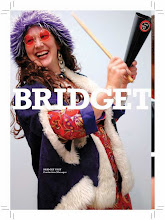skip to main |
skip to sidebar
Through adversity we become stronger… is that how it goes? I’m thinking perhaps that should be changed to “we become crazier,” because sometimes, I am completely blown away by Murphy’s Law. Just when you’ve moved over the threshold—BAM!—next!
At least it’s fodder for my blog. Here’s the story of our latest challenge.
We’re working on a business card for a relatively new client. It’s just a business card, right? Should be easy enough.
He’s looking for a very professional presentation, knowing that the business card is the first impression of his new brand (that we recently renamed and created a logo for). The typography on the card and his logo are white and yellow and the symbol has a little gradient in it that radiates out from the center.
Our designer came up with a great solution that looks beautiful, but producing this card, that’s another story, and as you’ll see, it’s complicated.
It’s not often that we are able to recommend printing on a specialty paper but for this project, it was certainly appropriate. Our paper selection was an uncoated linen 100# cover stock in navy blue. It’s a great sheet of paper, the perfect thickness, very high-end—blue on both sides.
I sent the request for an estimate to three separate vendors. Two of the three vendors replied with alternative solutions because printing white and yellow ink on blue paper, is a difficult—if not impossible—task that usually results in a negative outcome.
The first vendor recommended we go with a white paper, print blue and yellow on white, knocking out (aka reversing) the white type while printing. The second vendor recommended foil.
I went back to our designer with the first vendor’s recommendation. Nope. The original goal was to produce a card that would not get “white crusty edges.” The concern was that, once trimmed, the card would lose its verve, so to speak, and look less professional.
Alright, back to the drawing board. Vendor #3 offered to do some draw-downs of the yellow and white ink on the blue paper (samples of how the ink looks on the paper) so we could see what they looked like. When we got them back, we realized the Vendor #1 had a valid point. The yellow, ew!, it looked green! And the white didn’t really stand out.
Back to the drawing board. I got on the phone with Vendor #1. There were a couple additional concerns.
Another paper we specified was a linen blue and white duplex sheet—two 65# cover sheets essentially heat-glued together—with a 130# cover weight.
This brought up CONCERN #1) The limits of the press. For smaller runs with fewer colors, our print vendors typically use their smaller presses. It’s less expensive and opens space on their larger presses for bigger jobs. The issue with this is that many of those smaller presses can only handle papers up to 100# cover weight. Thus, the duplex sheet wouldn’t work on the more economical machine.
The benefit of the blue and white sheet was that if we chose to use it, we could easily print the inks on the white side and we could consider options for the blue side. Playing on the recommendation of Vendor #2, it was time to discuss foil.
Foil was a good option but, since the papers we chose were uncoated and **maybe** not thick enough, and because foiling requires you to essentially heat-set and press the design into the paper, this brought up CONCERN #2) USING FOIL ON AN UNCOATED SHEET WITH GRAPHIC ELEMENTS ON BOTH SIDES. It was likely that wherever the info was foiled, it would show through as a depression on the other side. Seriously? And, if we had chosen a coated stock, we’d have better luck because the coated stock is more compressed than an uncoated sheet and it would take the impression better. But the uncoated sheet speaks this brand! Alright, mental note, good to know.
Then, CONCERN #3) PRINTING A LIGHT GRADIENT ON A DARK SHEET OF PAPER. There is pretty much no way to print a white and yellow gradient on a blue piece of paper, unless you foil underneath it and then we’re back to problem #2.
I just want to see with my own eyes, what happens to this paper! Can I get a foil draw-down please? Oy. OK. The see-through is pretty apparent. Back to the drawing board.
What other options do we have if we want to avoid the tattered edges?
I looked into gilding the edges (coating the edges with gold/silver), even taking a sharpie to them (not really) but alas, ultimately, this project could not be completed as specified—at least not successfully, and we didn’t want to take that risk.
So, we’re back to the original recommendation—printing these on white paper, with reversed out type, 2-color job (blue and yellow). Looks like flaking edges are unavoidable but it’s a small price to pay for the peace of mind that the printed graphics will look great.
Note to self: Do not specify light colored inks on dark colored papers, especially if you have a two-sided design, it’s impossible to pull off from a production standpoint.



